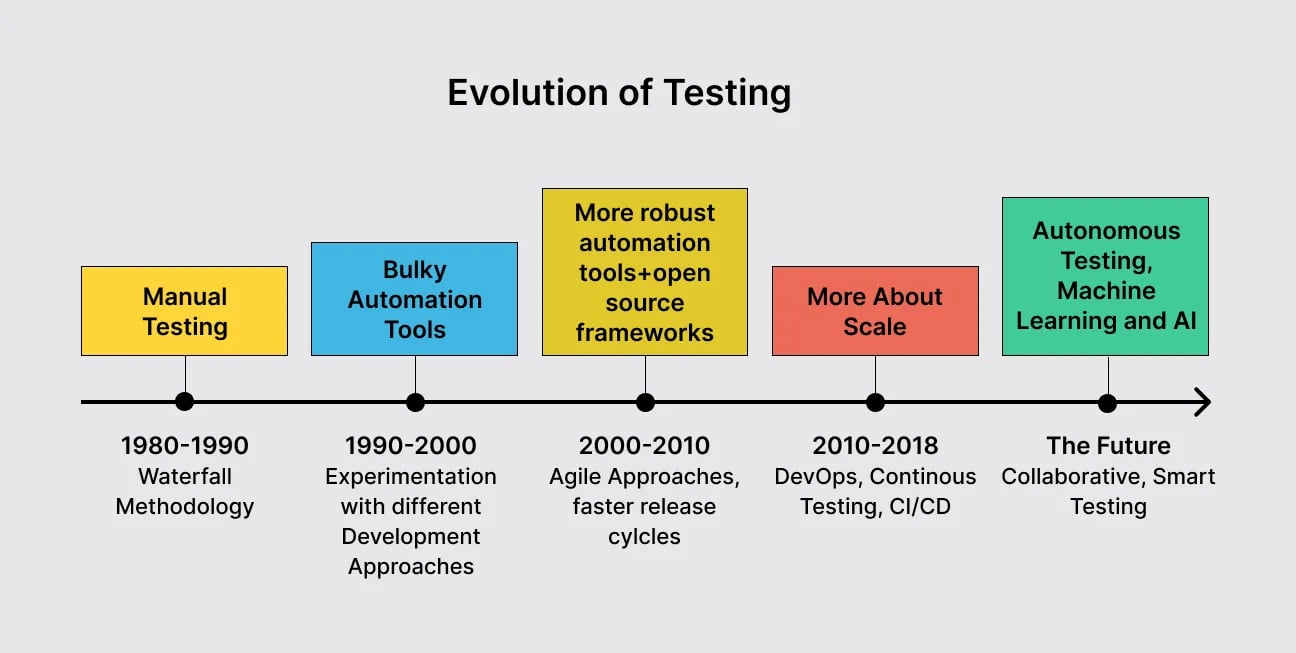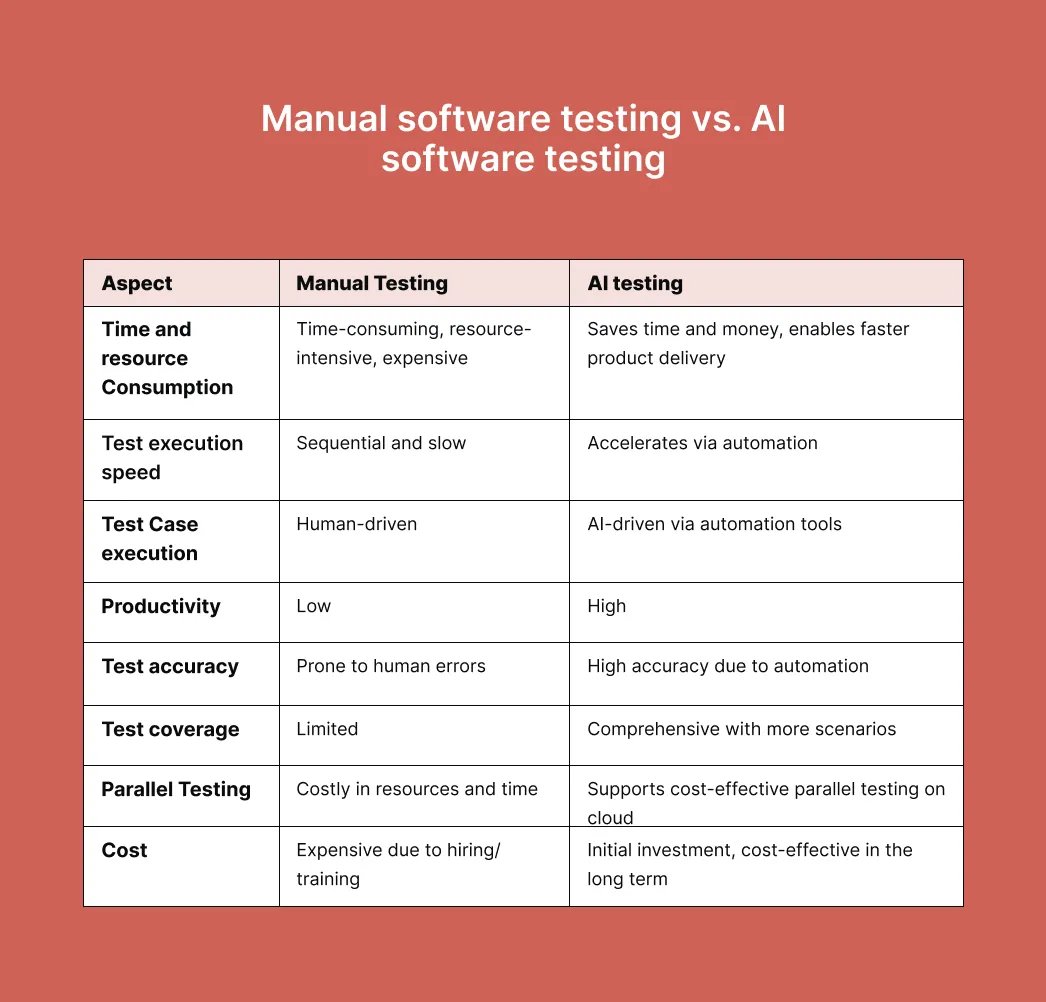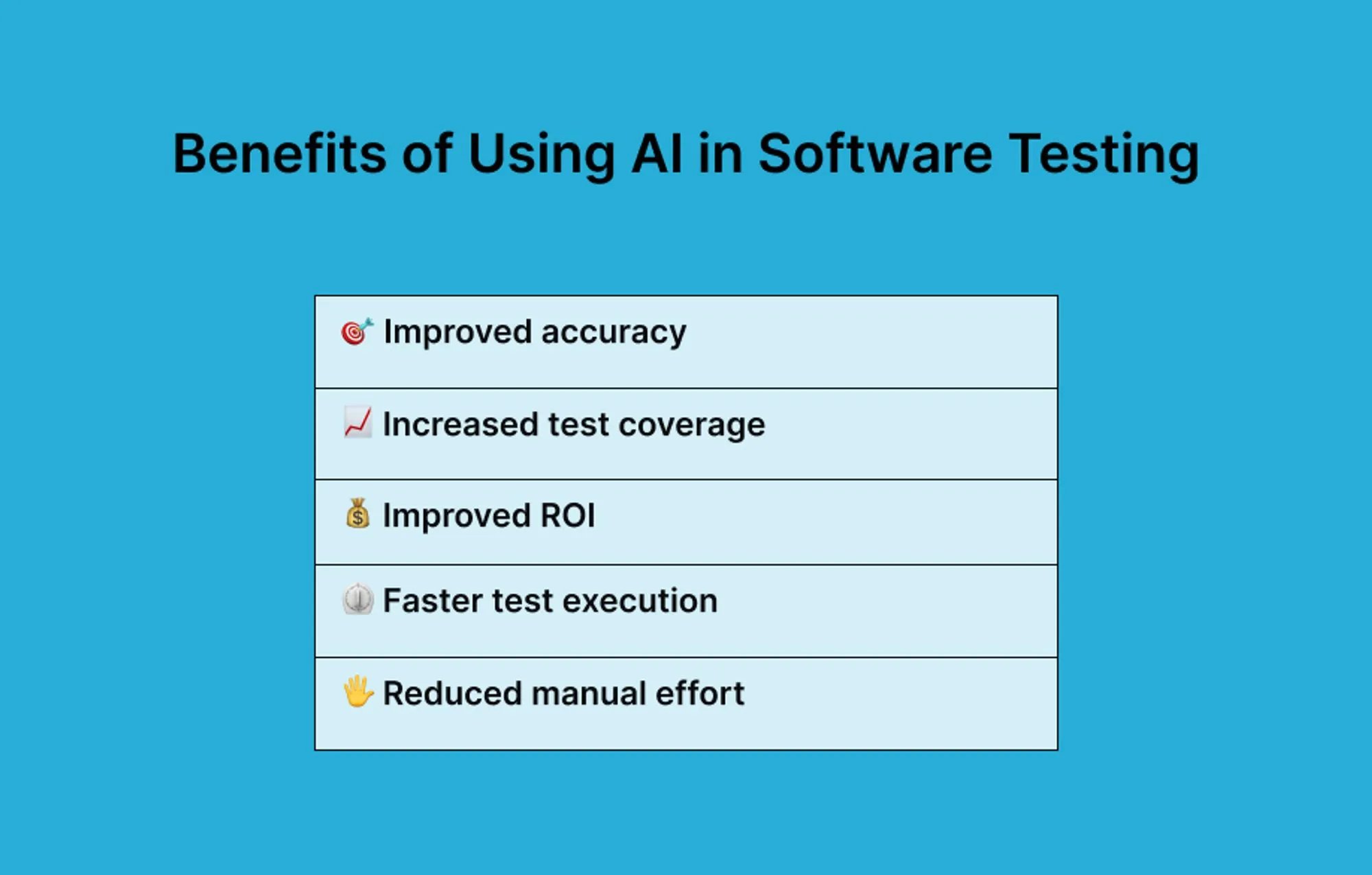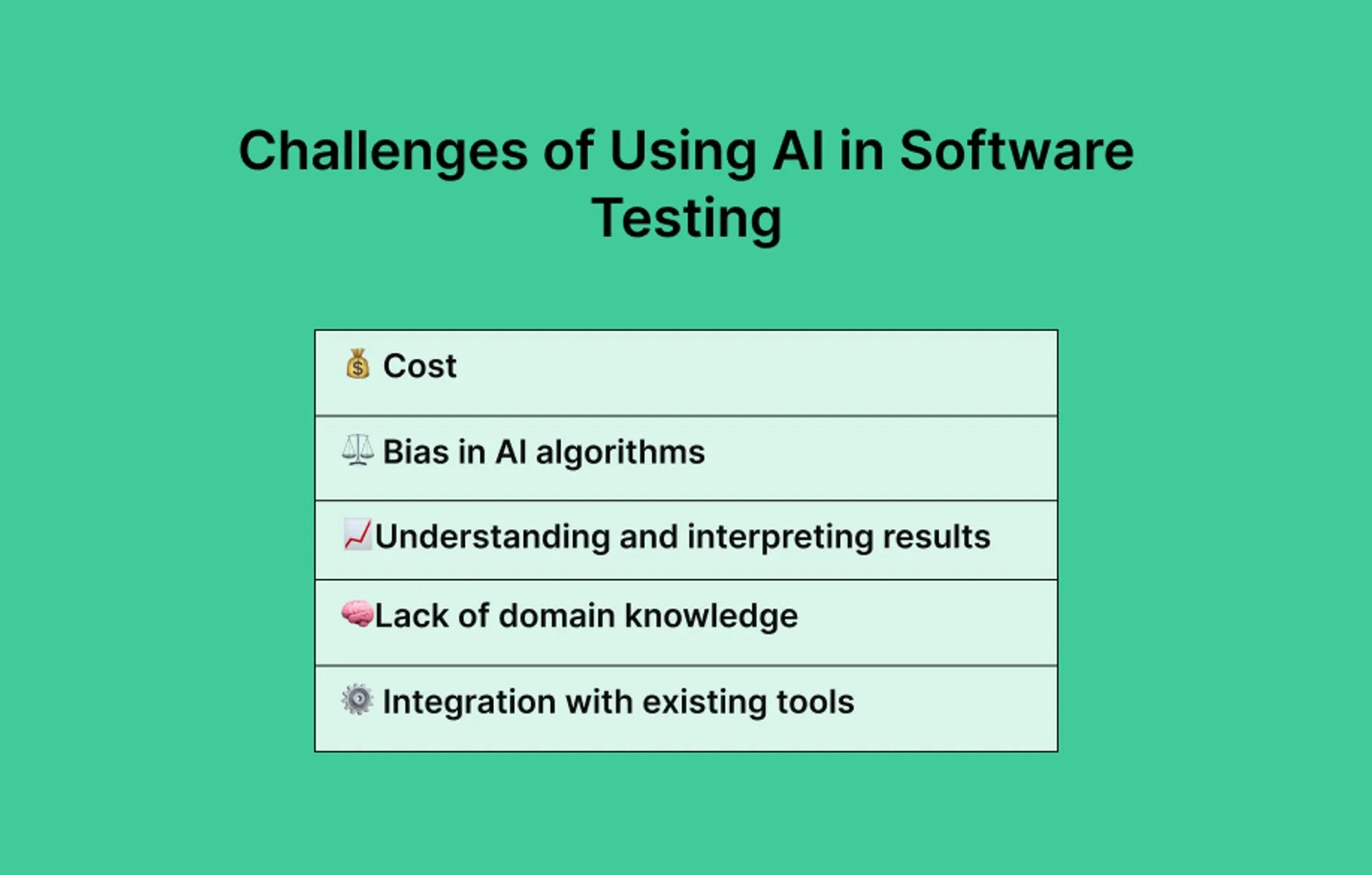Our guide to testing GenAI prodcuts and features
Over a brief period, AI has reshaped industries across the globe, presenting different opportunities and obstacles. Embracing AI is essential for businesses to remain competitive, especially in the QA domain, where AI testing is set to revolutionize software testing approaches. This text will go through the key aspects of AI software testing and explain how to use it. Let’s begin.
How is AI changing software testing?
Software testing has come a long way since its inception in the 1970s. Initially, the focus was on executing manual tests to identify defects in software applications. However, over the years, with technological advancements, automated AI-driven testing tools were introduced to save time and improve testing coverage.
Using AI-driven tools, testers can automate the testing process and reduce manual error, saving significant time and resources in the long run. AI algorithms can also continuously learn from new testing data to identify patterns and trends in defects and optimize the testing process over time. As AI evolves and new technologies develop, the potential for its impact on software testing continues to expand.

We can help you drive global growth, better accessibility and better product quality at every level.
Why do you need AI in testing?
AI testing is an approach to software testing that incorporates artificial intelligence and machine learning algorithms. There are several important reasons why AI is becoming an increasingly essential tool for software testing. Some of the key benefits include:
- Faster, more efficient testing: AI-based tools can automate much of the testing process, significantly reducing manual error and increasing testing speed.
- Improved accuracy and reliability: By leveraging AI algorithms, testers can quickly identify and resolve defects, ultimately increasing software reliability and achieving greater customer satisfaction.
- Cost savings: With less manual labor involved in testing, teams can save time and resources, resulting in cost savings and better ROI.
- Comprehensive testing coverage: AI-based tools have the potential to test applications across a multitude of operating systems, devices, and networks, allowing testers to identify flaws in a broad range of settings.
- Ongoing optimization: AI algorithms can continuously learn and adapt to new data, allowing testing to be optimized over time and ensuring consistent quality.
Manual software testing vs. AI software testing
The key differences between manual testing and AI testing lie in the reliance on human intervention for manual testing versus the automation enabled by AI tools. All this leads to variations in efficiency, accuracy, and coverage. Here are some of the key differences:

Benefits of using AI in software testing
The benefits of utilizing AI in software testing encompass enhanced accuracy, expanded test coverage, accelerated test execution, minimized manual effort, and improved return on investment (ROI). Let’s delve deeper into each of these benefits.

1. Improved test coverage
AI algorithms can quickly analyze large volumes of data to identify patterns and trends, enabling testers to identify potential defects across a broader range of software scenarios. AI-based testing tools can also simulate various conditions and environments, from different operating systems and device types to varying network conditions, ensuring that software is optimized to perform under real-world conditions.
2. Increased speed and efficiency
Automation accelerates the testing process, freeing testers and developers to focus on more strategic, creative, and high-value tasks. By employing AI-based testing tools, software development teams can speed up testing cycles and reduce the likelihood of human errors, saving time and resources in the long run.
3. Improved quality assurance
When integrating AI in the development and testing process, software development teams can deliver higher quality software to their end-users, reducing the probability of bugs and defects. As a result, it will enhance the overall user experience. Improved quality assurance can lead to higher customer satisfaction, fewer issues and support requests, and better business outcomes for software providers.
4. Cost savings
With automated testing supported by AI, there is less need for human resources. Even in cases where testers are still needed, AI technologies can reduce the burden on manual testers, allowing testing activities to become more streamlined and better aligned with overall software development goals. The savings from such techniques are considerable because of the reduced time required for testing cycles.
Challenges in using AI in software testing
Challenges in employing AI in software testing include managing costs, addressing biases in AI algorithms, comprehending and interpreting results, bridging knowledge gaps, and integrating with existing tools seamlessly. Let’s explore some of the key challenges of using AI testing.

1. Long learning curve
AI technologies can be complex, and building in-house expertise within a team can take considerable time and resources. This can lead to delays in implementing AI-based testing strategies, as teams require additional training and development to become proficient in AI techniques. Besides, a lack of knowledge of AI technologies can also lead to a lack of confidence in using AI-based tools, creating resistance to adopting new approaches within teams.
2. Difficulty in understanding the human context
AI algorithms can learn from historical data to identify patterns and make predictions. Still, they often lack the contextual information a human would have when testing software - to understand how users will use it fully. Testers might miss subtle issues that only a human would be capable of understanding, like how a user feels when using the software or what kind of past issues users have complained about.
Additionally, since each user has their preferences and constraints, AI-based testing may not be adequate to uncover user functions. Ultimately, the goal should be to strike the right balance between AI and human-based testing approaches, ensuring that human insights and AI-driven analytics are utilized to achieve optimal software quality.
3. Limited knowledge and adaptability
AI models often suffer from limited knowledge and adaptability, specifically regarding rare and exceptional situations and complex testing scenarios. For example, AI algorithms may be less effective in detecting defects only under specific configurations or low-frequency scenarios.
Also, AI models trained solely on historical data may not be effective in considering current or future trends, resulting in inaccurate or incomplete predictions. As AI technologies evolve, education and awareness of industry trends and best practices will be vital to achieving optimal results and overcoming these challenges in AI-based testing.
How to use AI in software testing
Here are some key steps that you can take when choosing if AI testing is required for your software:
1. Determine the relevance of AI testing for your software
Assessing the importance of AI testing for your software is important in optimizing your software testing approach. Some factors to consider include:
- The size, complexity, and criticality of the software
- The time and resources available for testing
- The need for consistent and repeatable testing processes
Overall, AI testing is suitable for software development projects requiring consistent, repeatable, and efficient testing.
2. Develop a test strategy
To develop a test strategy incorporating AI, the first step is to define your testing goals and objectives. Next, identify areas where AI can be effective, such as identifying defects, analyzing test results, or generating test cases. Determine which AI tools or technologies best suit each testing area and integrate them into your overall testing process. Develop protocols for collecting and utilizing test data and results and establish performance metrics to evaluate the effectiveness of your AI testing approach.
3. Choose the right AI tools
After you've decided AI testing is suitable for your software and have a test strategy ready, the next step is to pick the right tools. There are many AI tools out there, each with its own pros and cons. To make the right choice, start by clearly understanding what you need from your testing and what your goals are. Then, look into what each tool offers, especially focusing on how they can automate testing, find bugs, and help you improve based on the test results. Also, make sure the tool fits well with the software tools you already use and check if it's easy to add it to your current setup.
4. Invest in AI training
While AI testing has numerous benefits, AI is still a relatively new and complex technology. Therefore, it is important to provide your testing team with the knowledge and skills to implement and work effectively with AI tools. AI training can include technical and non-technical aspects, such as:
- Understanding AI concepts
- Using AI tools
- Analyzing test data
- Interpreting AI-generated results.
Training your team to merge AI testing with traditional manual testing methods is also important to create a well-rounded testing approach.
The future of AI in testing
The future of AI in testing is promising, with expected advancements set to make software testing more effective and efficient. Some potential developments include:
- Integration of AI in continuous testing enables faster and more accurate testing during development cycles.
- Improved natural language processing capabilities to enable AI-powered test case creation and execution without requiring coding knowledge.
- Increased use of machine learning algorithms to identify patterns and predict issues that may not be apparent during testing.
- Incorporation of AI-powered test automation tools that can perform testing tasks faster and more efficiently than traditional tools.
- Utilizing AI to analyze user behavior and feedback to identify areas that require improvement in software development.
- Development of AI-powered virtual assistants that can assist in test planning, execution, and reporting tasks.
How can Global app testing elevate your software quality
Global App Testing is a leading provider of software testing solutions for businesses of all sizes. Some key highlights of our services include:
- Manual testing to ensure comprehensive coverage of all aspects of software functionality.
- Crowdsourced testing to leverage the power of a diverse and flexible testing workforce.
- Exploratory testing to uncover defects that may not be caught using traditional testing methods.
- Performance testing to assess the speed, stability, and scalability of software applications.
- Localization testing to ensure software compatibility across a variety of languages and cultures.
Do you want to learn more about our services? Book a call today, and let’s partner up for all your software development endeavors!
FAQ
Is AI testing suitable for all types of software?
Yes, AI testing can be applied to various software types, including web applications, mobile apps, and enterprise systems.
Can AI testing be combined with traditional testing approaches?
Yes, AI testing can complement traditional approaches like manual and automated testing, enhancing overall testing efficiency and effectiveness.
Is AI testing suitable for complex software architectures?
AI testing is adaptable to complex architectures and can efficiently handle intricate software systems.
We can help you drive localization as a key initiative aligned to your business goals
Keep learning
The only software testing checklist you need
Quality Assurance vs Quality Control
How to write a test strategy document for your testing

